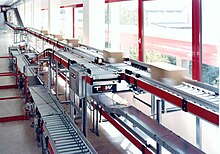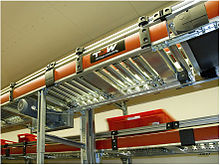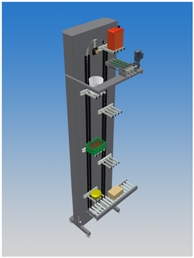Conveyor system
This article needs additional citations for verification. (September 2015) |

A conveyor system is a common piece of mechanical handling equipment that moves materials from one location to another. Conveyors are especially useful in applications involving the transportation of heavy or bulky materials. Conveyor systems allow quick and efficient transportation for a wide variety of materials, which make them very popular in the material handling and packaging industries. They also have popular consumer applications, as they are often found in supermarkets and airports, constituting the final leg of item/ bag delivery to customers. Many kinds of conveying systems are available and are used according to the various needs of different industries. There are chain conveyors (floor and overhead) as well. Chain conveyors consist of enclosed tracks, I-Beam, towline, power & free, and hand pushed trolleys.
Industries that use conveyor systems



Conveyor systems are used widespread across a range of industries due to the numerous benefits they provide.
- Conveyors are able to safely transport materials from one level to another, which when done by human labor would be strenuous and expensive.
- They can be installed almost anywhere, and are much safer than using a forklift or other machine to move materials.
- They can move loads of all shapes, sizes and weights. Also, many have advanced safety features that help prevent accidents.
- There are a variety of options available for running conveying systems, including the hydraulic, mechanical and fully automated systems, which are equipped to fit individual needs.
Conveyor systems are commonly used in many industries, including the Mining, automotive, agricultural, computer, electronic, food processing, aerospace, pharmaceutical, chemical, bottling and canning, print finishing and packaging. Although a wide variety of materials can be conveyed, some of the most common include food items such as beans and nuts, bottles and cans, automotive components, scrap metal, pills and powders, wood and furniture and grain and animal feed. Many factors are important in the accurate selection of a conveyor system. It is important to know how the conveyor system will be used beforehand. Some individual areas that are helpful to consider are the required conveyor operations, such as transportation, accumulation and sorting, the material sizes, weights and shapes and where the loading and pickup points need to be.
Care and maintenance of conveyor systems
A conveyor system is often the lifeline to a company's ability to effectively move its product in a timely fashion. The steps that a company can take to ensure that it performs at peak capacity, include regular inspections and system audits, close monitoring of motors and reducers, keeping key parts in stock, and proper training of personnel.
Increasing the service life of a conveyor system involves: choosing the right conveyor type, the right system design and paying attention to regular maintenance practices.
A conveyor system that is designed properly will last a long time with proper maintenance. Here are six of the biggest problems to watch for in overhead type conveyor systems including I-beam monorails, enclosed track conveyors and power and free conveyors. Overhead conveyor systems have been used in numerous applications from shop displays, assembly lines to paint finishing plants and more.[1]
Poor take-up adjustment: this is a simple adjustment on most systems yet it is often overlooked. The chain take-up device ensures that the chain is pulled tight as it leaves the drive unit. As wear occurs and the chain lengthens, the take-up extends under the force of its springs. As they extend, the spring force becomes less and the take-up has less effect. Simply compress the take-up springs and your problem goes away. Failure to do this can result in chain surging, jamming, and extreme wear on the track and chain. Take-up adjustment is also important for any conveyor using belts as a means to power rollers, or belts themselves being the mover. With poor-take up on belt-driven rollers, the belt may twist into the drive unit and cause damage, or at the least a noticeable decrease or complete loss of performance may occur. In the case of belt conveyors, a poor take-up may cause drive unit damage or may let the belt slip off of the side of the chassis.
Lack of lubrication: chain bearings require lubrication in order to reduce friction. The chain pull that the drive experiences can double if the bearings are not lubricated. This can cause the system to overload by either its mechanical or electrical overload protection. On conveyors that go through hot ovens, lubricators can be left on constantly or set to turn on every few cycles.
Contamination: paint, powder, acid or alkaline fluids, abrasives, glass bead, steel shot, etc. can all lead to rapid deterioration of track and chain. Ask any bearing company about the leading cause of bearing failure and they will point to contamination. Once a foreign substance lands on the raceway of a bearing or on the track, pitting of the surface will occur, and once the surface is compromised, wear will accelerate. Building shrouds around your conveyors can help prevent the ingress of contaminants. Or, pressurize the contained area using a simple fan and duct arrangement. Contamination can also apply to belts (causing slippage, or in the case of some materials premature wear), and of the motors themselves. Since the motors can generate a considerable amount of heat, keeping the surface clean is an almost-free maintenance procedure that can keep heat from getting trapped by dust and grime, which may lead to motor burnout.
Product handling: in conveyor systems that may be suited for a wide variety of products, such as those in distribution centers, it is important that each new product be deemed acceptable for conveying before being run through the materials handling equipment. Boxes that are too small, too large, too heavy, too light, or too awkwardly shaped may not convey, or may cause many problems including jams, excess wear on conveying equipment, motor overloads, belt breakage, or other damage, and may also consume extra man-hours in terms of picking up cases that slipped between rollers, or damaged product that was not meant for materials handling. If a product such as this manages to make it through most of the system, the sortation system will most likely be the affected, causing jams and failing to properly place items where they are assigned. Any and all cartons handled on any conveyor should be in good shape or spills, jams, downtime, and possible accidents and injuries may result.
Drive train: notwithstanding the above, involving take-up adjustment, other parts of the drive train should be kept in proper shape. Broken O-rings on a Lineshaft, pneumatic parts in disrepair, and motor reducers should also be inspected. Loss of power to even one or a few rollers on a conveyor can mean the difference between effective and timely delivery, and repetitive nuances that can continually cost downtime.
Bad belt tracking or timing: in a system that uses precisely controlled belts, such as a sorter system, regular inspections should be made that all belts are traveling at the proper speeds at all times. While usually a computer controls this with Pulse Position Indicators, any belt not controlled must be monitored to ensure accuracy and reduce the likelihood of problems. Timing is also important for any equipment that is instructed to precisely meter out items, such as a merge where one box pulls from all lines at one time. If one were to be mistimed, product would collide and disrupt operation. Timing is also important wherever a conveyor must "keep track" of where a box is, or improper operation will result.
Since a conveyor system is a critical link in a company's ability to move its products in a timely fashion, any disruption of its operation can be costly. Most downtime can be avoided by taking steps to ensure a system operates at peak performance, including regular inspections, close monitoring of motors and reducers, keeping key parts in stock, and proper training of personnel.
Impact and wear-resistant materials used in conveyor systems
Conveyor systems require materials suited to the displacement of heavy loads and the wear-resistance to hold-up over time without seizing due to deformation. Where static control is a factor, special materials designed to either dissipate or conduct electrical charges are used. Examples of conveyor handling materials include UHMW, nylon, Nylatron NSM, HDPE, Tivar, Tivar ESd, and polyurethane.
Growth of conveyor systems in various industries
As far as growth is concerned the material handling and conveyor system makers are getting utmost exposure in the industries like automotive, pharmaceutical, packaging and different production plants. The portable conveyors are likewise growing fast in the construction sector and by the year 2014 the purchase rate for conveyor systems in North America, Europe and Asia is likely to grow even further. The most commonly purchased types of conveyors are Line shaft roller conveyor, chain conveyors and conveyor belts at packaging factories and industrial plants where usually product finishing and monitoring are carried. Commercial and civil sectors are increasingly implementing conveyors at airports, shopping malls, etc.
Types of conveyor systems


- Aero-mechanical conveyors
- Automotive conveyors
- Belt conveyor
- Belt-driven live roller conveyors
- Bucket conveyor
- Chain conveyor
- Chain-driven live roller conveyor
- Drag conveyor
- Dust-proof conveyors
- Electric track vehicle systems
- Flexible conveyors
- Gravity conveyor
- Gravity skatewheel conveyor
- Lineshaft roller conveyor
- Motorized-drive roller conveyor
- Overhead I-beam conveyors
- Overland conveyor
- Pharmaceutical conveyors
- Plastic belt conveyors
- Pneumatic conveyors
- Screw or auger conveyor
- Spiral conveyors
- Vertical conveyors
- Vibrating conveyors
- Wire mesh conveyors
Pneumatic conveyor systems
Every pneumatic system uses pipes or ducts called transportation lines that carry a mixture of materials and a stream of air. These materials are free flowing powdery materials like cement and fly ash. Products are moved through tubes by air pressure. Pneumatic conveyors are either carrier systems or dilute-phase systems; carrier systems simply push items from one entry point to one exit point, such as the money-exchanging pneumatic tubes used at a bank drive-through window. Dilute-phase systems use push-pull pressure to guide materials through various entry and exit points. Air compressors or blowers can be used to generate the air flow. Three systems used to generate high-velocity air stream:
- Suction or vacuum systems, utilizing a vacuum created in the pipeline to draw the material with the surrounding air. The system operated at a low pressure, which is practically 0.4–0.5 atm below atmosphere, and is utilized mainly in conveying light free flowing materials.
- Pressure-type systems, in which a positive pressure is used to push material from one point to the next. The system is ideal for conveying material from one loading point to a number of unloading points. It operates at a pressure of 6 atm and upwards.
- Combination systems, in which a suction system is used to convey material from a number of loading points and a pressure system is employed to deliver it to a number of unloading points.
Vibrating conveyor systems
A vibrating conveyor is a machine with a solid conveying surface which is turned up on the side to form a trough. They are used extensively in food-grade applications to convey dry bulk solids [2] where sanitation, washdown, and low maintenance are essential. Vibrating conveyors are also suitable for harsh, very hot, dirty, or corrosive environments. They can be used to convey newly-cast metal parts which may reach upwards of 1,500 °F (820 °C). Due to the fixed nature of the conveying pans vibrating conveyors can also perform tasks such as sorting, screening, classifying and orienting parts. Vibrating conveyors have been built to convey material at angles exceeding 45° from horizontal using special pan shapes. Flat pans will convey most materials at a 5° incline from horizontal line.
Flexible conveyor systems
The flexible conveyor is based on a conveyor beam in aluminum or stainless steel, with low-friction slide rails guiding a plastic multi-flexing chain. Products to be conveyed travel directly on the conveyor, or on pallets/carriers. These conveyors can be worked around obstacles and keep production lines flowing. They are made at varying levels and can work in multiple environments. They are used in food packaging, case packing, and pharmaceutical industries and also in large retail stores such as Wal-Mart and Kmart.
Vertical conveyor systems and spiral conveyors
Vertical conveyors, also commonly referred to as freight lifts and material lifts, are conveyor systems used to raise or lower materials to different levels of a facility during the handling process. Examples of these conveyors applied in the industrial assembly process include transporting materials to different floors. While similar in look to freight elevators, vertical conveyors are not equipped to transport people, only materials.
Vertical lift conveyors contain two adjacent, parallel conveyors for simultaneous upward movement of adjacent surfaces of the parallel conveyors. One of the conveyors normally has spaced apart flights (pans) for transporting bulk food items. The dual conveyors rotate in opposite directions, but are operated from one gear box to ensure equal belt speed. One of the conveyors is pivotally hinged to the other conveyor for swinging the attached conveyor away from the remaining conveyor for access to the facing surfaces of the parallel conveyors.[3] Vertical lift conveyors can be manually or automatically loaded and controlled.[4] Almost all vertical conveyors can be systematically integrated with horizontal conveyors, since both of these conveyor systems work in tandem to create a cohesive material handling assembly line.
Like vertical conveyors, spiral conveyors raise and lower materials to different levels of a facility. In contrast, spiral conveyors are able to transport material loads in a continuous flow. A helical spiral or screw rotates within a sealed tube and the speed makes the product in the conveyor rotate with the screw. The tumbling effect provides a homogeneous mix of particles in the conveyor, which is essential when feeding pre-mixed ingredients and maintaining mixing integrity.[5] Industries that require a higher output of materials - food and beverage, retail case packaging, pharmaceuticals - typically incorporate these conveyors into their systems over standard vertical conveyors due to their ability to facilitate high throughput. Most spiral conveyors also have a lower angle of incline or decline (11 degrees or less) to prevent sliding and tumbling during operation.

Like spiral conveyors, vertical conveyors that use forks can transport material loads in a continuous flow. With these forks the load can be taken from one horizontal conveyor and put down on another horizontal conveyor on a different level. By adding more forks, more products can be lifted at the same time. Conventional vertical conveyors must have input and output of material loads moving in the same direction. By using forks many combinations of different input- and output- levels in different directions are possible. A vertical conveyor with forks can even be used as a vertical sorter. Compared to a spiral conveyor a vertical conveyor - with or without forks - takes up less space.
Vertical reciprocating conveyors (or VRC) are another type of unit handling system. Typical applications include moving unit loads between floor levels, working with multiple accumulation conveyors, and interfacing overhead conveyors line. Common material to be conveyed includes pallets, sacks, custom fixtures or product racks and more.[6]
Heavy-duty roller conveyors
Heavy-duty roller conveyors are used for moving items that weigh at least 500 pounds (230 kg). This type of conveyor makes the handling of such heavy equipment/products easier and more time effective. Many of the heavy duty roller conveyors can move as fast as 75 feet per minute (23 m/min).
Other types of heavy-duty roller conveyors are gravity roller conveyors, chain-driven live roller conveyors, pallet accumulation conveyors, multi-strand chain conveyors, and chain and roller transfers.
Gravity roller conveyors are easy to use and are used in many different types of industries such as automotive and retail.
Chain-driven live roller conveyors are used for single or bi-directional material handling. Large, heavy loads are moved by chain driven live roller conveyors.
Pallet accumulation conveyors are powered through a mechanical clutch. This is used instead of individually powered and controlled sections of conveyors.
Multi-strand chain conveyors are used for double-pitch roller chains. Products that cannot be moved on traditional roller conveyors can be moved by a multi-strand chain conveyor.
Chain and roller conveyors are short runs of two or more strands of double-pitch chain conveyors built into a chain-driven line roller conveyor. These pop up under the load and move the load off of the conveyor.
See also
References
- ^ "Overhead Conveyors and Material Handling". Mhel.co.uk. Archived from the original on 2016-09-02. Retrieved 2016-08-23.
- ^ "Archived copy". Archived from the original on 2018-01-03. Retrieved 2018-01-02.
{{cite web}}: CS1 maint: archived copy as title (link) - ^ "Vertical Lift Conveyors". Freepatentsonline.com. Retrieved 2013-03-27.
- ^ "Conveyors". Mhia.org. 2005-07-16. Archived from the original on 2012-03-04. Retrieved 2013-03-27.
- ^ "Spiroflow". Retrieved 27 May 2019.
- ^ "Vertical Lift & Reciprocating Conveyor Manufacturer | Industrial Kinetics". Iki.com. Retrieved 30 August 2019.
M.Marcu-Pipeline Conveyors (theory,photos,state of the art 1990-Pneumatic Pipeline conveyors with wheeled containers) at page 45 in: "Material handling in pyrometallurgy: proceedings of the International Symposium on Materials Handling in Pyrometallurgy, Hamilton, Ontario, August 26–30, 1990-Pergamon press"
